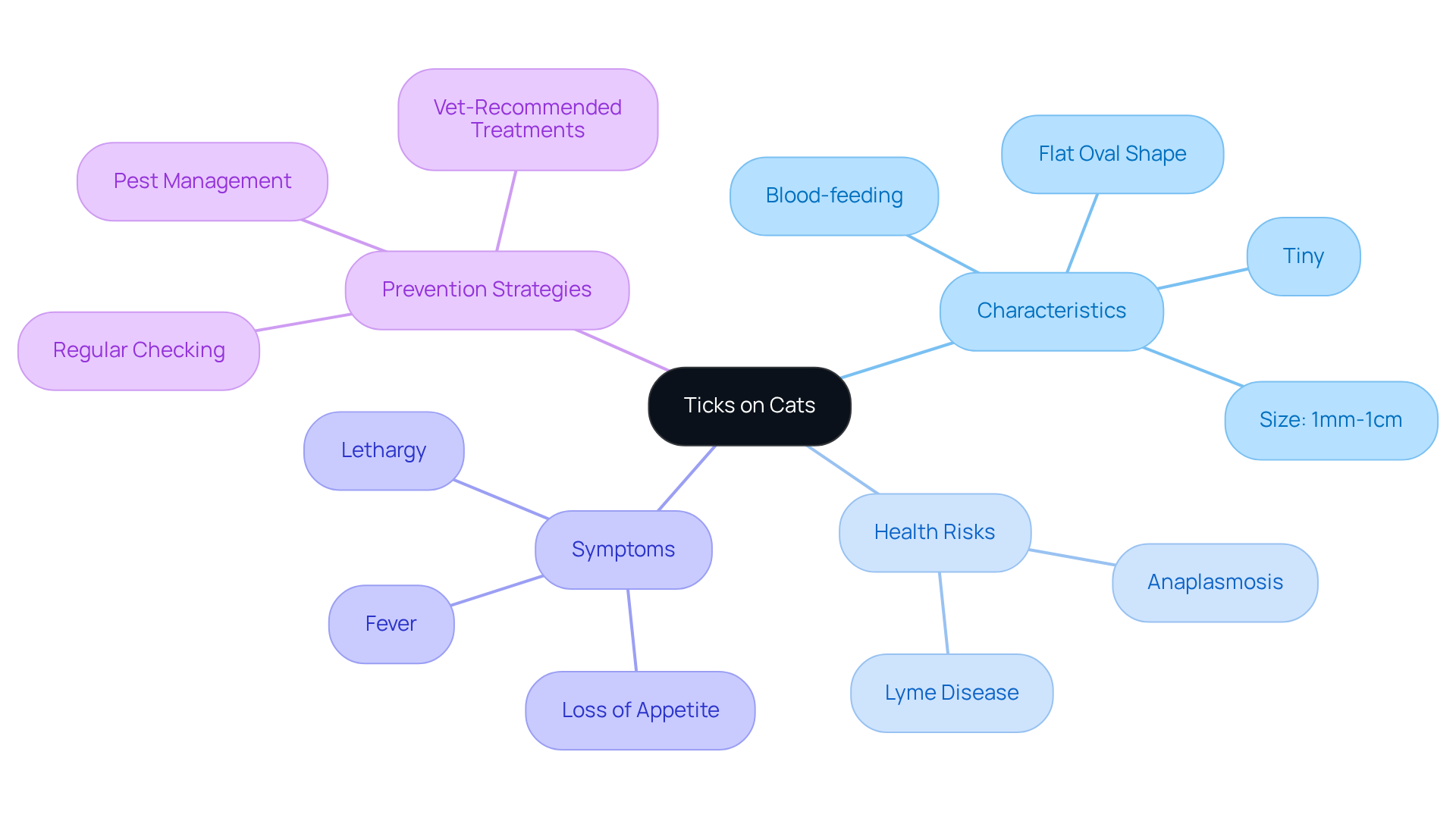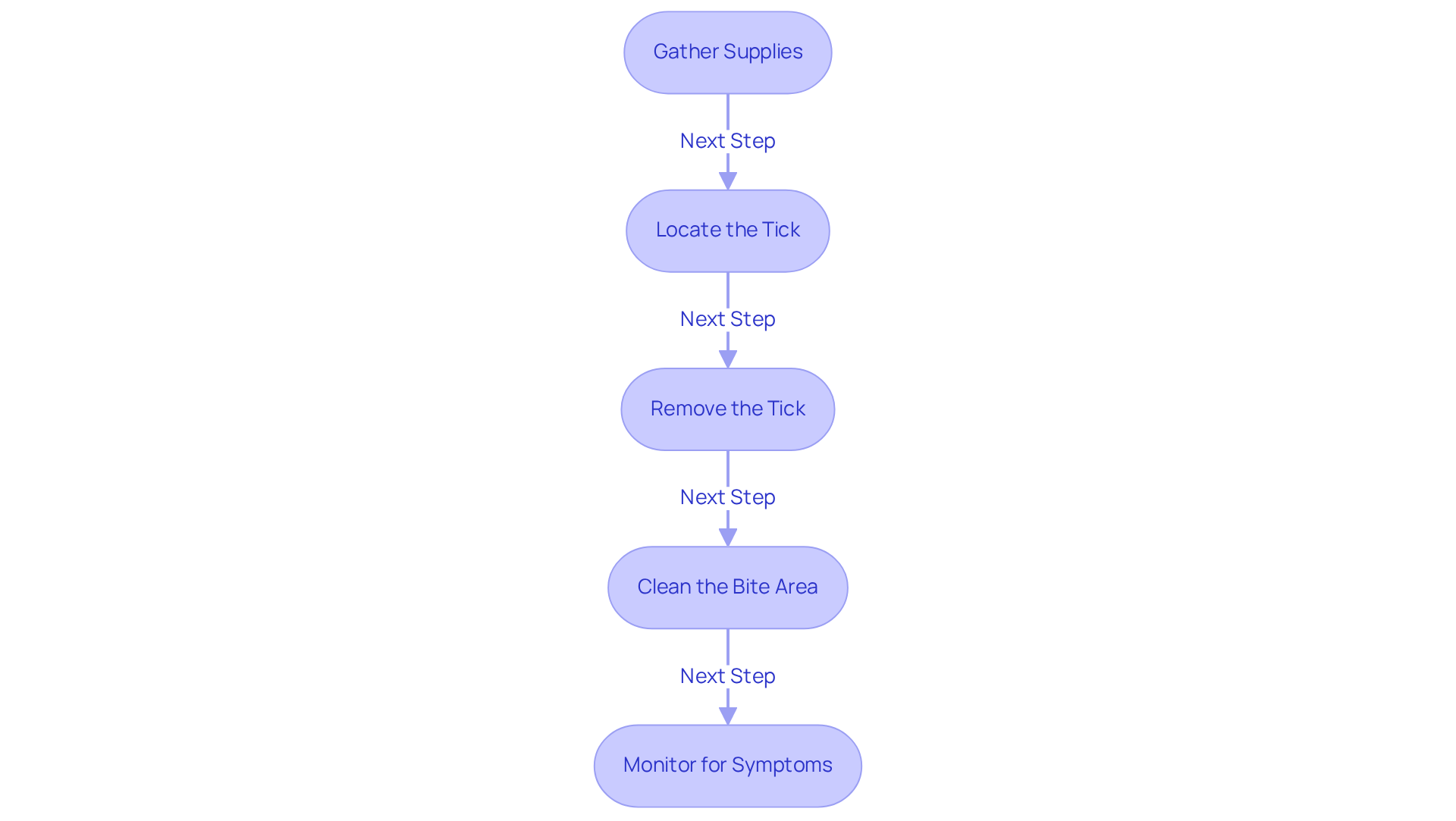
Ticks on Cats: Identify, Remove, and Prevent Effectively
Overview
As a pet owner, the thought of ticks on your beloved cat can be deeply concerning. These tiny creatures pose significant health risks, including the transmission of serious diseases like Lyme disease and anaplasmosis.
It’s understandable to feel anxious about the well-being of your furry friend. That’s why it’s crucial to prioritize:
- Identification of ticks
- Removal of ticks
- Prevention of ticks
Regular checks for ticks are essential, and knowing the appropriate removal techniques can make a world of difference.
Additionally, utilizing veterinarian-recommended preventive measures can help safeguard your cat’s health and provide you with peace of mind. Together, we can ensure that your feline companion remains safe and healthy, allowing you both to enjoy countless happy moments together.
Introduction
Ticks are more than just a nuisance for our beloved cats; they are dangerous parasites that can lead to serious health issues. With their small size and ability to transmit diseases like Lyme disease and anaplasmosis, these blood-feeding creatures pose significant risks to our feline companions.
As pet owners, it’s natural to worry about the well-being of our furry friends. This article offers a comprehensive guide on how to identify, safely remove, and effectively prevent ticks, ensuring that you are equipped with the knowledge to protect your cherished cats.
But what steps can we take together to mitigate the risks associated with these hidden threats, and how can we stay vigilant in the face of such challenges? Your cat’s health and happiness are worth every effort.
Identify Ticks: Characteristics and Behavior
Ticks on cats are tiny, blood-feeding parasites that pose significant dangers to our beloved felines. Measuring between 1mm and 1cm, these little creatures can be identified by their flat, oval shape and dark brown or black coloration. With eight legs, they often lurk in wooded or grassy areas, patiently waiting to attach themselves to a host as it brushes against plants.
Once they connect, these parasites can remain on their host for several days, feeding on blood, which can lead to serious health issues such as Lyme disease and anaplasmosis. It’s concerning to note that information from Banfield Pet Hospitals reveals that the occurrence of parasites in pets ranges from 0.9% to 13.3%, underscoring the importance of being vigilant.
Symptoms of tick-borne illnesses in our feline friends, especially related to ticks on cats, may include:
- Fever
- Lethargy
- Loss of appetite
This makes it essential for pet owners to stay alert to these signs. Regularly checking your cat for ticks on cats, especially after outdoor adventures, is vital for early detection and effective management. It’s important to remember that even indoor cats can be at risk if they step outside, even for a moment.
Therefore, implementing regular pest management strategies, including veterinarian-recommended flea and pest treatments, is crucial to safeguard your pet’s health and happiness.

Understand Tick-Borne Diseases: Risks and Symptoms
Ticks on cats pose a significant risk to the health of our beloved feline companions, as they can transmit serious ailments like Lyme infection, anaplasmosis, and ehrlichiosis. It’s concerning to note that recent studies indicate that Lyme illness has been found in 13.9% of cats in certain areas, with 22.6% of those affected having been bitten by ticks on cats that carry Borrelia burgdorferi. This highlights the importance of vigilance among pet owners who care deeply for their furry friends. Symptoms of tick-borne diseases can manifest in various ways, including:
- Fever
- Lethargy
- Loss of appetite
- Joint pain
Less common signs, such as a bloody nose, unexplained bruising, and seizures, can also occur, making it crucial for cat owners to stay observant. In severe cases, these conditions can lead to serious health complications, including organ failure or even death if left untreated.
For example, anaplasmosis, caused by the bacterium Anaplasma phagocytophilum, often presents with lethargy and fever. Thankfully, it can be effectively treated with doxycycline at a dosage of 10 mg/kg PO q24h for 21 to 28 days, with many pets showing improvement within just 24 to 48 hours. It’s essential for cat owners to closely observe their pets for any unusual behavior or symptoms following ticks on cats. Early detection and prompt treatment are vital for improving outcomes, making awareness of these risks crucial for responsible pet ownership.
To help protect our cats from diseases transmitted by ticks on cats, consistent grooming and the application of year-round flea and parasite preventatives, such as Revolution Plus, can significantly reduce the risk. Furthermore, after removing a tick, it is important to cleanse the bite wound with soap and water and monitor the area for signs of infection. By taking these steps, we can ensure our feline friends remain healthy and happy, allowing us to enjoy many more precious moments together.

Remove Ticks Safely: Step-by-Step Guide
Removing ticks on cats can be a worrying experience, but with the right steps, you can do it safely and effectively. Here’s how to approach this delicate situation with care:
-
First, gather your supplies: fine-tipped tweezers, gloves, antiseptic, and a small container with a lid. Wearing gloves is essential to protect yourself from any potential diseases during this process.
-
Next, gently part your cat’s fur to locate the tick, ensuring it is clearly visible. This may feel daunting, but remember that you are acting in your pet’s best interest. Using the tweezers, grasp the tick as close to your cat’s skin as possible, being careful not to squeeze its body. With a steady, even pull, gently lift the tick upward. Avoid twisting or jerking, as this can cause parts of the tick to break off and remain in your cat’s skin.
-
Once you have removed the tick, place it in the container and seal it. Keeping the tick can be helpful for identification purposes, should any issues arise later. Afterward, clean the bite area with antiseptic and keep a close eye on your cat for any signs of infection or illness.
-
If you notice any unusual symptoms, such as swollen lymph nodes, fever, or loss of appetite, or if the tick was attached for a longer period, it’s important to consult your veterinarian for further advice.
Statistics show that timely and proper removal of ticks on cats is crucial, as these parasites can carry illnesses like Lyme disease, which may lead to serious complications if left untreated. The estimated treatment failure rate for Lyme disease is between 10-20%, underscoring the importance of following these steps carefully. Remember, even with preventive measures in place, it’s wise to examine your cat for ticks after outdoor adventures to help ensure their health. You’re not alone in this; caring for our pets is a shared journey, and together we can ensure their well-being.

Prevent Ticks: Effective Strategies for Cat Owners
To effectively prevent ticks on your beloved cat, it’s important to consider a few caring strategies that prioritize their well-being:
-
Routine grooming is essential. By brushing your cat consistently, you can inspect for any pesky parasites and gently eliminate those that might be present. This not only keeps your cat looking their best but also helps you stay aware of their health.
-
Utilizing preventatives is another crucial step. Consulting your veterinarian about suitable prevention products, such as topical treatments or collars, can provide peace of mind. Your vet can recommend the best options tailored to your cat’s needs, ensuring they remain safe from ticks on cats.
-
Limiting outdoor exposure during peak seasons for these pests is wise, especially in areas known for high tick populations. Keeping your cat indoors during these times can significantly reduce their risk of encountering ticks on cats.
-
Maintaining your yard is also important. Regularly mowing the lawn and clearing away debris creates a less inviting environment for ticks, making it safer for your cat to explore outdoors.
-
Creating a tick-free zone in your yard can be a fun way for your cat to enjoy the outdoors safely. Designate areas that are away from tall grass and wooded spots, providing a secure space for your cat to play and relax.
-
Lastly, scheduling regular veterinary check-ups is vital for monitoring health issues such as ticks on cats. These visits not only ensure your cat stays healthy but also give you the opportunity to discuss any concerns regarding ticks and other parasites with your veterinarian. This ongoing care reflects your commitment to your pet’s health and happiness.

Conclusion
Ticks on cats present a significant health risk that requires proactive measures from pet owners. We understand how distressing it can be to think about the dangers these parasites pose to our beloved furry friends. By learning to identify, remove, and prevent ticks, you can take meaningful steps to protect your cat from the serious threats of tick-borne diseases. Remember, even a brief outdoor excursion can expose cats to these pests, highlighting the importance of regular checks and preventive care.
This article sheds light on the characteristics and behaviors of ticks, the serious health risks they pose, and the symptoms of tick-borne diseases that you should be vigilant about. It offers a detailed, step-by-step guide on safely removing ticks, along with the crucial importance of post-removal care. Furthermore, we discuss effective prevention strategies, such as:
- Routine grooming
- Using veterinary-recommended products
- Managing the environment
All of which are essential components of a comprehensive approach to keeping your cats safe from ticks.
Ultimately, ensuring the health and happiness of your cats in relation to tick exposure is a shared responsibility. By implementing the strategies outlined here, you can create a safer environment for your feline companions. Taking these proactive steps not only enhances their well-being but also fosters a deeper bond between you and your pets, allowing for many joyful moments together, free from the worry of tick-related health issues.
